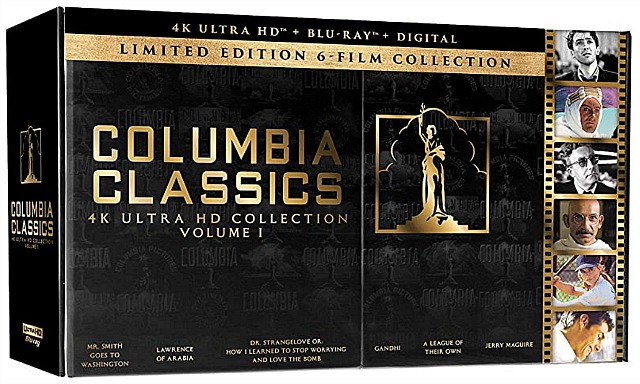Just before Christmas of 2016 I purchased a UHD 4K streaming version of Lawrence of Arabia, which had been released almost a year earlier. I was deeply impressed or, as I wrote on 12.20.16, “really, seriously stunned by the micro-detail.”
I knew it wasn’t real-deal 4K because of digital compressing, and that it actually represented an image density that was somewhere between 2K and 3K.
And yet “for the first time in my life, I was noticing textures in Freddie Young‘s 70mm cinematography (wood grain, extra-tiny sand pebbles, wardrobe threads, even the subtle composition of fine cement in the opening credits sequence) that I’d literally never seen before, not with this degree of crispness and clarity, and that’s saying something.”
On June 16th fans of David Lean’s 1962 Oscar-winner will be able to own a 4K version, even though it’ll cost them $111.82 because it’s part of a box-set package deal that includes Mr. Smith Goes to Washington, Dr. Strangelove, Gandhi, A League of Their Own and Jerry Maguire.

This morning I asked restoration guru Robert Harris, who guided the original 1988 restoration (and who worked closely with Lean for weeks on end) and was involved on all levels with the newbie, how the 4K disc version compares with the streaming version.
“Far better,” Harris replied. “The streaming version is, of necessity, highly compressed. The 4k UHD is spread over 2 triple-layer discs. No comparison. Gandhi and A League Of Their Own are also magnificent. They look like film. But Aurens…other-worldly.”
The 4K UHD Lawrence, he said, is “the equivalent of 750-800 pounds of 70mm film on 13 reels, captured to a couple of discs that probably weigh about an ounce.”
A portion of Harris’s Home Theatre Forum review:
“The new 4K release of Lawrence of Arabia has seemingly reached home video nirvana.
“Everything that one might wish for is here. The film has been split across two discs, for maximum data throughput. Dolby Atmos has been added for a bit of height, which works nicely. Color, black levels, shadow detail and general densities all work nicely. Grain structure is superb. Image stability is perfect.
“For those unaccustomed to the film, be aware that it’s four hours long, has no women with speaking roles, spends hours watching men cross deserts on camels, and has no musical numbers.
“It’s all about this slightly looney Brit who seems to enjoy pain, and takes pleasure in burning himself with matches.
“It was originally released in December of 1962 at 232 minutes inclusive of music. In January, twenty minutes was removed, making certain sequences a bit incoherent, and in 1970, supposedly only for American TV, it was shorn of another fifteen minutes, leading to a wonderful article in the New York Times, entitled ‘Look What They’ve Done to Lawrence of Arabia Now.’
“Most people seemed to enjoy the 202-minute cut (212 with music), until a slightly looney American became involved and put back most of the pieces that had been cut, finally ending up with a Director’s Cut at 227 minutes with music.
“Those elements were digitized in 2012 by Columbia’s Grover Crisp, leading to what we have today.”
Except from Bluray.com review: “To be perfectly frank, the entirety of the Columbia Classics collection is worth buying for the UHD Lawrence alone. One can almost consider the other five films bonuses. This one looks that good. It’s breathtaking, and it’s impossible to imagine even the most stringent videophile not smiling the whole way through.
“The Atmos soundtrack is first-rate, too. There is one new, brief extra but the carryover content is perfectly fine in support. What a gem of a film and of a UHD. Of course, Lawrence of Arabia‘s UHD disc earns my highest recommendation.”









